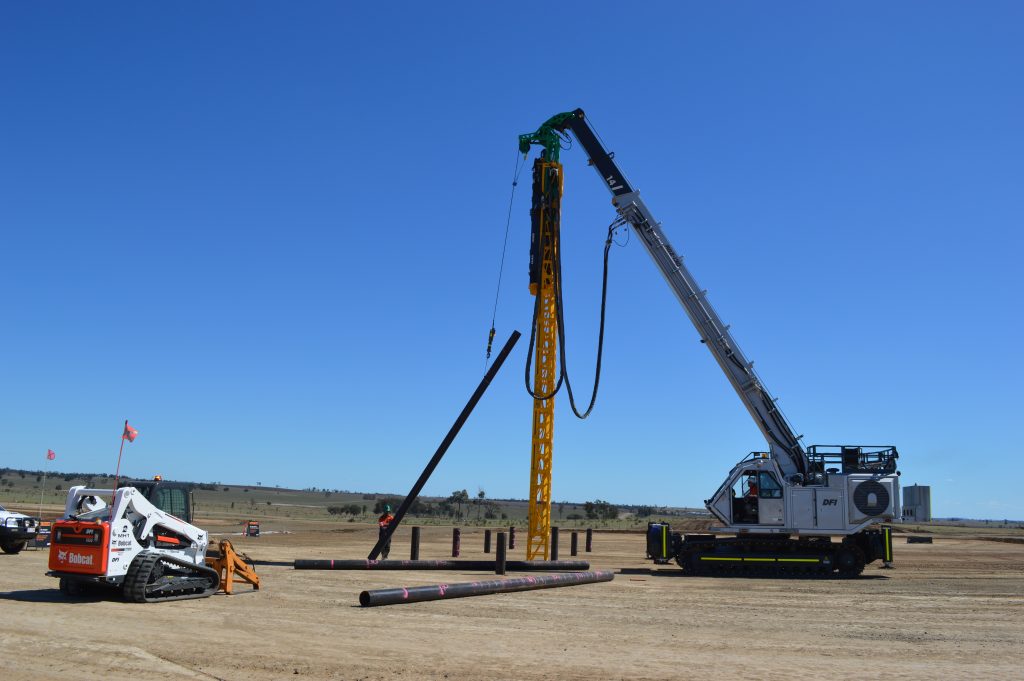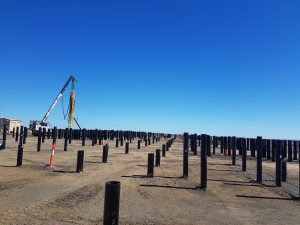Steel driven piles allow for fast turnaround on new compression facility
Completing a project ahead of schedule not only saves time, but can reduce labour and equipment costs. On a recent field compression facility project in Queensland- a first of its kind in Australia- a steel pile foundation with more than 900 steel driven piles was installed in only 24 days with a crew of four personnel, due to effective installation techniques.

The new field compression facility, located North East of Wandoan in Queensland, will be different to other facilities due to large horsepower reciprocating compressors being directly mounted to the driven pile system.
DFI Energy Services (DFI) became involved with the project in the feed stage by assisting the client with transitioning their design from a traditional mass concrete foundation to a steel driven foundation system. DFI were then contracted for the supply, installation (including driving of piles and pre-drilling as required), and pile capacity testing.
Once installed, the piles will support structures such as switch rooms, pipe racks, control rooms, pipe supports, TEG packages, and large reciprocating compressors.
Previously, the foundations of gas compression and process facilities were typically made from concrete, but lately Australian companies have been switching to steel foundation systems because it significantly reduces time and installation costs, which is extremely beneficial in the gas industry’s current economic climate.
 From scepticism to savings
From scepticism to savings
As the nominated piling contractor, DFI were required to procure and manufacture all of the material for the foundation, including 38 unique pile types, direct from the mill of manufacture in Asia.
Initially, the project managers on site were skeptical of DFI’s proposed schedule, specifically their anticipated production levels, especially after Cyclone Debbie occurred and caused several significant trans-shipment delays.
Matt Meyer, Regional Manager Australasia at DFI, said despite the challenges, the first shipment of material was delivered to site only 63 days post award and DFI’s scope of the project was completed ahead of schedule, surprising the facility owner, designing engineer firm, and general contractor.
“Supply chain management was one of the largest challenges DFI faced with this project, but we were able to source, procure and deliver the material in such a short window because of our relationships within the industry,” he said.
“It was because of these existing relationships that we were able to shave a month off the typical delivery lead times.”
 Major benefits of steel driven pile systems
Major benefits of steel driven pile systems
Mr Meyer said installing a steel pile foundation took only a fraction of the time it would have taken to install traditional concrete foundations, and it also reduced the need for other equipment onsite.
“The DFI crew of four personnel replaced a concrete crew of 12 and DFI’s single piling unit replaced all the equipment that would be required for a concrete installation, such as batching plant, excavation equipment, concrete trucks and concrete pumpers,” he said.
“I can’t confirm the exact cost benefit but it has been estimated that the steel driven pile system for this site offered a 65 per cent saving over the mass concrete option.”
The outcome was so impressive that the facility owner decided to add more than 200 piles to the program and have them installed by DFI before they demobilised. These new piles will support expansion packages that were not scheduled to be installed for over a year.
Now, DFI is working with six other producers on major facility designs for 2018 works, and later this year will be supporting installations at three other compressor stations in Queensland and the Northern Territory.
Read more about the benefits of replacing concrete foundations with steel piles here.



